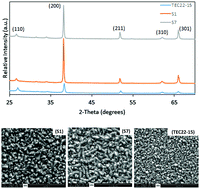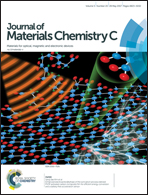1 cm2 CH3NH3PbI3 mesoporous solar cells with 17.8% steady-state efficiency by tailoring front FTO electrodes†
Abstract
In this article, we investigate the effects of atmospheric-pressure chemical vapour deposited fluorine doped tin oxide (FTO) thin films as front electrodes for the fabrication of mesoporous perovskite solar cells with an active area of 1 cm2 and compare them with the use of a commonly used commercial transparent conducting oxide. The effects of sheet resistance (Rs) and surface roughness are both closely linked to the film thickness. In order to separate out these effects the characteristics of the deposited FTOs were carefully controlled by changing the fluorine doping levels and the number of passes under the coating head to give films of specific thicknesses or Rs. Under AM 1.5 Sun illumination and maximum power point tracking, the optimised FTOs yielded a steady-state power conversion efficiency of 17.8%, higher than that of the reference cell fabricated from the commercial FTO. We attribute the improved cell efficiency to increased fill factor and a lower series resistance resulting from the lower Rs and increased thickness of these FTO substrates. This low-cost and viable methodology is the first such type of study looking independently at the significance of FTO roughness and resistance for highly efficient mesoporous perovskite solar cells.



 Please wait while we load your content...
Please wait while we load your content...